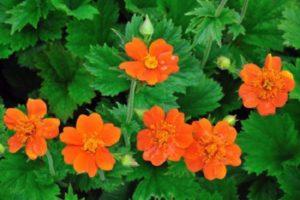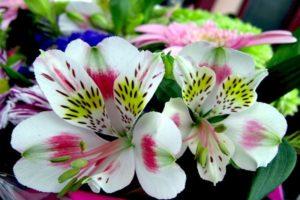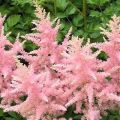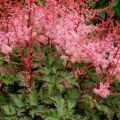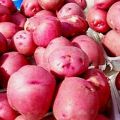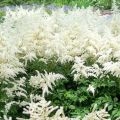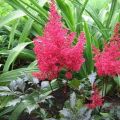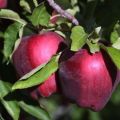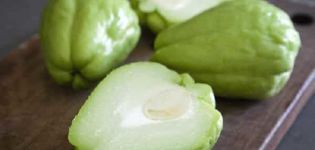Description of the variety of Chinese astilba Visions in red, cultivation and reproduction
Among all the varieties of astilba, Chinese Vision is considered one of the most attractive. Large purple inflorescences highlight this flower in flower beds and front gardens. The lush flowering shrub is resistant to adverse conditions and tolerates seasonal changes in weather well. The variety is actively used in landscaping both independently and as part of compositions. The variety name is also found in the spelling of Visions, Visions or in other interpretations of the original Astilbe chinensis Visions in red.
General information about Chinese Astilbe Visions ed
The origin of astilba is associated with the territory of the Primorsky Territory, China, the Korean Peninsula and Japan. A wild flower was first described in the first half of the 19th century. The plant has been cultivated by botanists throughout Europe and has been bred for at least 150 years. During this time, not only the habitat of culture has expanded, but also the variety of decorative characteristics has changed significantly.
Purple astilba Chinese Vision in red outwardly differs significantly from other plant varieties, but retains its natural unpretentiousness. In terms of altitude, the variety belongs to low, and in the shape of inflorescences - to rhombic.
All plants of the Vision series are bred to enhance their attractiveness, the leaves have a pronounced texture, and the inflorescences are distinguished by their splendor and variegated palette.
Description and characteristic features of the variety
Variety Astilbe chinensis Visions red is mainly distinguished by a rich red shade of inflorescences and shoots, on which are located green leaves with a bronze tint. The plant is resistant to lack of moisture and calmly tolerates bright sunlight, although it prefers light partial shade. Winter hardiness in this variety is quite high and corresponds to the 4th zone, thus Vision Red is able to survive frosts down to -34 ° С. The plant grows quickly and confidently in the open area and displaces weaker crops and weeds.
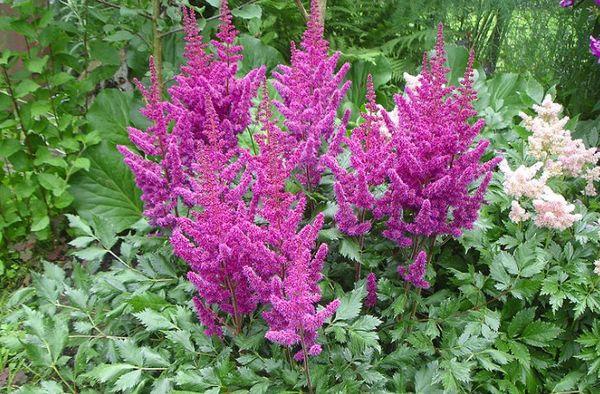
Hive external data
Astilba Visions in red belongs to low-growing varieties and reaches a height of no more than 50 cm.At the same time, the green part of the plant is located at the level of 30 cm, and the peduncles rise above them by another 10-20 cm.Astilba shoots are straight and strong, with a smooth surface. Leaves with a serrated edge, pinnate, oval, slightly elongated. The root of the plant is placed vertically or with a slight slope. Each year, the rhizome increases by 2-4 cm in height, which leads to the need for a constant increase in the bulk soil at the base of the flower.
All about blooming
Flowering of Astilba Visions in red varieties falls on the period from July to August. At this time, the peduncles are covered with lush dense inflorescences in a shape close to a rhombus. Large groups consist of small fragrant bright flowers with a rich reddish-purple hue. Fully open petals have a lighter tone.
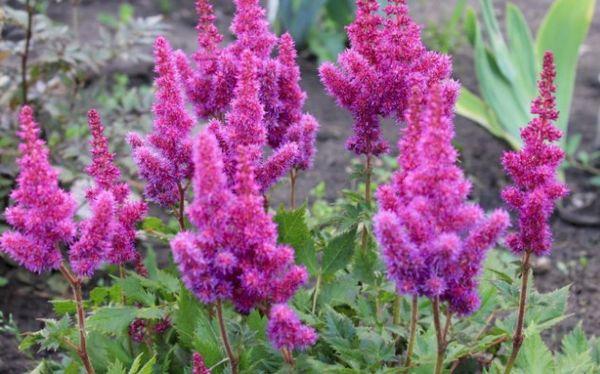
How culture reproduces
There are several ways to reproduce the Chinese astilba Visions in ed:
- seminal;
- vegetative.
If the peduncles of plants are not removed after flowering, the seeds of the plant can ripen on their own and disperse in the surrounding area. When self-sowing, varietal qualities may be lost, so this method is better suited for growing astilba from seeds purchased in the store. To reproduce the bushes already on the site, it is worth using the vegetative method. There are 2 options for such reproduction: by dividing the bush and replacing buds.
Requirements for climatic conditions and soil
Climatic requirements for cultivation of the variety Vision in red must correspond to the 4th zone of winter hardiness. As for the morphological composition of the soil, the plant can be planted in any soil if it is loose enough and does not lead to prolonged stagnation of moisture or rapid drying. It is possible to plant a flower on sandstones only in partial shade conditions and the subsequent abundant mulching of the site. The ideal option for planting is well-fertilized, clay-dung or loamy soil, which can be neutral or slightly acidic.

Planting a plant on the site
In garden design, Visions in red astilbe is used both in single plantings and in group. Joint planting is possible in:
- mixborders;
- discounts;
- curbs;
- shady alpine slides;
- flower beds around tree trunks;
- large containers.
When planting astilba, it is worth taking into account the condition of the soil and light load, since the plant perceives drought and overheating of the soil extremely negatively.
Choosing a suitable place
For planting astilba, an area with light partial shade is best suited. The abundance of direct sunlight leads to more active, but shorter flowering. The variety does not tolerate cultivation in places with dry air, low humidity is detrimental to the flower.
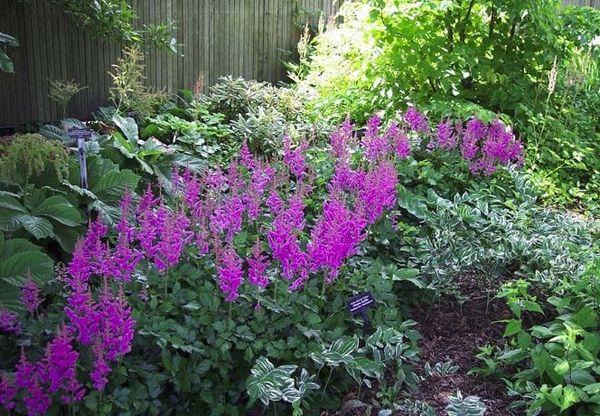
What culture gets along with and what it doesn't
Ideal for joint planting with Astilba Visions in ed:
- hosts;
- hyacinths;
- tulips;
- saxifrage;
- daylilies;
- phlox;
- bells;
- high cereals.
In the foreground of the culture, you can plant Heuchera, Badan and Geranium. You can plant lilies of the valley, podophyllum, hellebore, horned goat, irises or kupena next to it. You should not plant light-loving flowers near this variety, as well as small plants that can be replaced by more resistant astilba.
Terms and technology of planting a flower
Seeds of Vision in red are sown in open ground in late autumn, and for seedlings from February to March. They are placed on top of previously dug, fertilized and abundantly watered soil, without burying or covering with a layer of earth. After the emergence of seedlings, the plants are seated at a greater distance from each other. Seedlings are planted in a permanent place in summer or autumn.
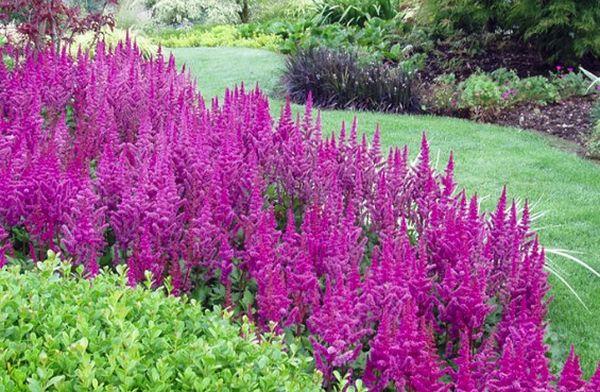
Reproduction by dividing the rhizome is the easiest way. It is advisable to carry out the process at the beginning of summer or from the end of August to September.To do this, bushes about 4 years old are dug out of the ground and divided into equal parts, so that several buds are preserved on each. Each part is planted in a new place and watered abundantly with warm water.
The use of individual replacement buds makes the flower propagation a little more difficult. Buds about 6 cm high are cut from the rhizome, capturing its tissues. The planting material is placed in a container filled with a mixture of peat, turf and sand. After 15-20 days, the buds take root and are ready for planting in a permanent place.
Astilbe is placed in such a way that the grown bushes are not closer than 0.3 m from each other. After planting, the plants are mulched with crushed peat or compost to maintain the required moisture level.
Care
Astilbe does not need constant careful care, she is loyal and hardy. Regular watering, combined with proper feeding and loose soil, allows you to grow attractive shrubs with minimal labor.
Watering and spraying
In order to grow lush, healthy astilbe varieties Visions in red, it is necessary to monitor the degree of soil moisture at the roots. The soil and rhizomes must not be allowed to dry out, this can lead not only to a deterioration in appearance, but also to the death of the flower. Plants need to be watered often, especially in dry weather, and at low levels of humidity, spraying can be supplemented.
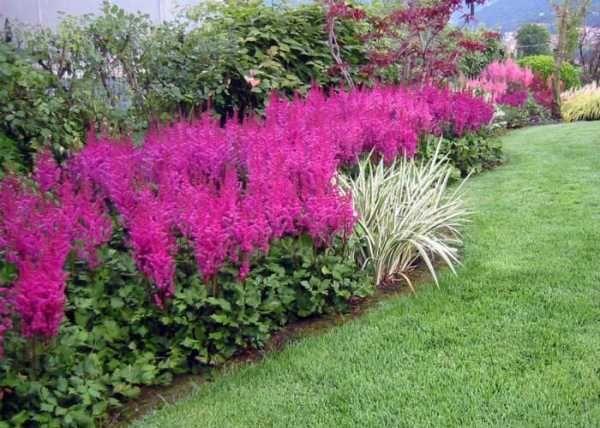
Top dressing and soil loosening
The complex of fertilizers for the fruitful growth of astilba depends on the quality of the soil. It is advisable to add compost and peat to dry soil; for wet soil, it is quite universal feeding for flowering plants. When planting bushes, mineral fertilizers and bone meal with humus are added to the soil. After the end of flowering, potassium-phosphorus fertilizing can be added to the soil poor in composition. It is advisable to accompany each watering by loosening the soil so that moisture and oxygen flow to the roots of the plant.
Formation of bushes
To improve the decorativeness of the culture, it is worth completely cutting off dry and damaged shoots. To maintain attractiveness, it is also recommended to remove the stalks after flowering. It is advisable to divide the growing bushes into parts every 4 years in order to relieve the load and restore the decorative effect of astilba. The rhizomes need to be cut into pieces, keeping at least one replacement bud, and the bushes must be planted in a new place.
Prevention of insects and diseases
Natural pests of astilbe are absent in the middle lane, however, plants can infect nematodes or strawberry worms. The appearance of brown spots, growths on the roots and deformation of leaves can be prevented by using fungicides in time.
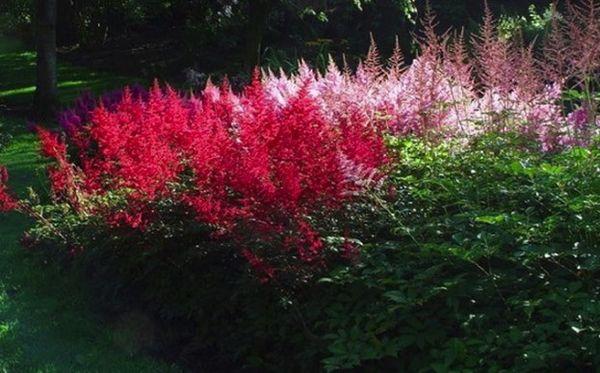
Pennitsa larvae can cause damage to the bushes, which makes the flower wither and lose its green part. To combat the pest, you can use "Karbofos", which is also suitable for prevention.
Astilba can pick up viral or fungal infections from nearby plants. The easiest way to protect the plant is by timely removal of weeds and damaged areas, as well as prophylactic spraying with Fitoverm, Confidor or analogues.
How to protect a plant from frost
In autumn, after the end of the growing season, the aboveground part of the Vision flowers is completely cut off. In conditions of severe frost or insufficient snow cover, it is recommended to protect the bushes from freezing. Visions in red can be covered with natural or artificial materials.
What problems can arise when growing
Growing astilba from seeds is hampered by the tiny size of the material, the amount of which in 1 g reaches 20 thousand.
As it grows, the Chinese Astilba variety Visions in red does not form dense growth, which does not allow the bush to be divided too often.
